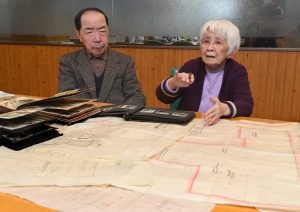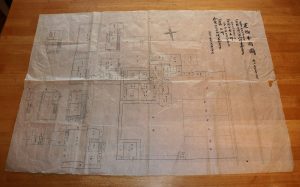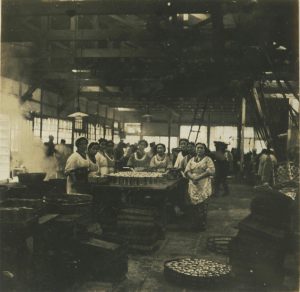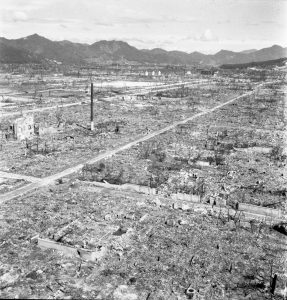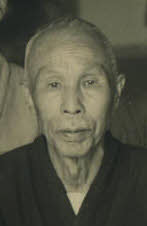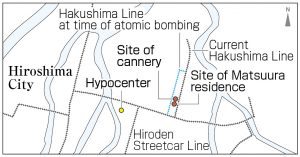Floor plans of cannery, adjacent residence to be donated to Hiroshima City by founder’s grandson
Mar. 23, 2020
(by Miho Kuwajima, Staff Writer)
Taijiro Matsuura (1872–1953) operated a canning factory in Teppo-cho (now part of Naka Ward) before World War II. His grandson Isao Matsuura, 82, a resident of Naka Ward, possesses six drawings, including the floor plan of the family’s residence, which stood next to the factory. Since the factory was located about 800 meters from the hypocenter, the drawings represent rare materials giving a glimpse of the cityscape before it was annihilated in the atomic bombing. Mr. Matsuura is to soon donate the drawings to the city government.
Taijiro and his brother Taichi Kato founded a canning factory in Sorazaya-cho (now part of Naka Ward) in 1895. Their business grew because of military demand during the Russo-Japanese War. Taijiro opened his own factory in 1905. Taijiro’s factory in Teppo-cho was constructed around 1913. Its name was changed from Matsuura Shoten (Matsuura Store) to Sanyo Kanzume (Sanyo Canning) around 1930. According to the Hiroshima City Museum of History and Traditional Crafts, the company supplied the military with canned goods such as beef, mikan oranges, and matsutake mushrooms.
The six drawings to be donated include a survey drawing, created in December 1930, of the 2,260 square-meter site of the residence. The floor plan of the residence, located to the south of the factory, provides an image of the property with its large garden, a tearoom, and houses for rent. Yoshie Kono, 92, a resident of Aki Ward, is a relative of the family. She boarded at the Matsuura’s residence when she was a student at Hiroshima Prefectural First Girls’ High School (now Minami High School). “The home was big. I went to the factory on errands and saw big chunks of beef hanging there and many employees going in and out,” Ms. Kono said.
But the factory became a subsidiary of Hiroshima Ken Godo Kanzume (Hiroshima Prefectural Joint Canning) through a merger under wartime controls in 1943. The family’s residence was requisitioned by the military, and Taijiro moved to the village Akikoshi (now part of the town of Shiraki-cho in Asakita Ward). The factory and the residence were burned to the ground in the atomic bombing. Taijiro’s oldest son and his son’s two family members, his second son, and oldest daughter, who were still living in and around the Teppo-cho area, were killed in the bombing. Only a chimney and a three-storied ferroconcrete storehouse escaped utter destruction.
Isao and his wife Fusae, 73, found the drawings seven years ago when they were sorting out the things his grandfather had left at their parents’ home in Shiraki-cho. They also found photographs of the factory taken before the bombing. They decided to donate the materials. “If they are privately owned, they can become scattered and lost,” Isao said. “I want future generations to know that my grandfather and others did good work and that there was a factory here before the war.”
Hirotaka Matsushima, head of Hiroshima City’s Cultural Promotion Division, said, “We can see that the residence had many rooms and that the canning factory had ample facilities. These are rare materials that illustrate one aspect of Hiroshima’s modern history.”
(Originally published on March 23, 2020)
Will be used as materials to illustrate busy cannery before the atomic bombing
Taijiro Matsuura (1872–1953) operated a canning factory in Teppo-cho (now part of Naka Ward) before World War II. His grandson Isao Matsuura, 82, a resident of Naka Ward, possesses six drawings, including the floor plan of the family’s residence, which stood next to the factory. Since the factory was located about 800 meters from the hypocenter, the drawings represent rare materials giving a glimpse of the cityscape before it was annihilated in the atomic bombing. Mr. Matsuura is to soon donate the drawings to the city government.
Taijiro and his brother Taichi Kato founded a canning factory in Sorazaya-cho (now part of Naka Ward) in 1895. Their business grew because of military demand during the Russo-Japanese War. Taijiro opened his own factory in 1905. Taijiro’s factory in Teppo-cho was constructed around 1913. Its name was changed from Matsuura Shoten (Matsuura Store) to Sanyo Kanzume (Sanyo Canning) around 1930. According to the Hiroshima City Museum of History and Traditional Crafts, the company supplied the military with canned goods such as beef, mikan oranges, and matsutake mushrooms.
The six drawings to be donated include a survey drawing, created in December 1930, of the 2,260 square-meter site of the residence. The floor plan of the residence, located to the south of the factory, provides an image of the property with its large garden, a tearoom, and houses for rent. Yoshie Kono, 92, a resident of Aki Ward, is a relative of the family. She boarded at the Matsuura’s residence when she was a student at Hiroshima Prefectural First Girls’ High School (now Minami High School). “The home was big. I went to the factory on errands and saw big chunks of beef hanging there and many employees going in and out,” Ms. Kono said.
But the factory became a subsidiary of Hiroshima Ken Godo Kanzume (Hiroshima Prefectural Joint Canning) through a merger under wartime controls in 1943. The family’s residence was requisitioned by the military, and Taijiro moved to the village Akikoshi (now part of the town of Shiraki-cho in Asakita Ward). The factory and the residence were burned to the ground in the atomic bombing. Taijiro’s oldest son and his son’s two family members, his second son, and oldest daughter, who were still living in and around the Teppo-cho area, were killed in the bombing. Only a chimney and a three-storied ferroconcrete storehouse escaped utter destruction.
Isao and his wife Fusae, 73, found the drawings seven years ago when they were sorting out the things his grandfather had left at their parents’ home in Shiraki-cho. They also found photographs of the factory taken before the bombing. They decided to donate the materials. “If they are privately owned, they can become scattered and lost,” Isao said. “I want future generations to know that my grandfather and others did good work and that there was a factory here before the war.”
Hirotaka Matsushima, head of Hiroshima City’s Cultural Promotion Division, said, “We can see that the residence had many rooms and that the canning factory had ample facilities. These are rare materials that illustrate one aspect of Hiroshima’s modern history.”
(Originally published on March 23, 2020)

